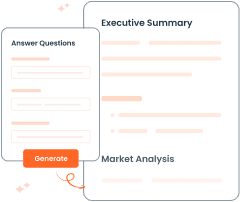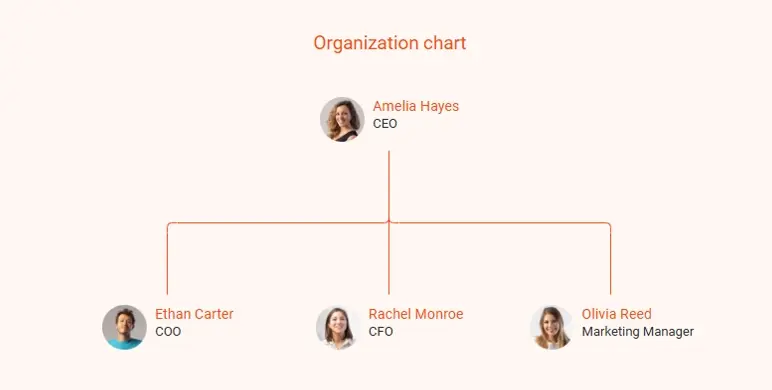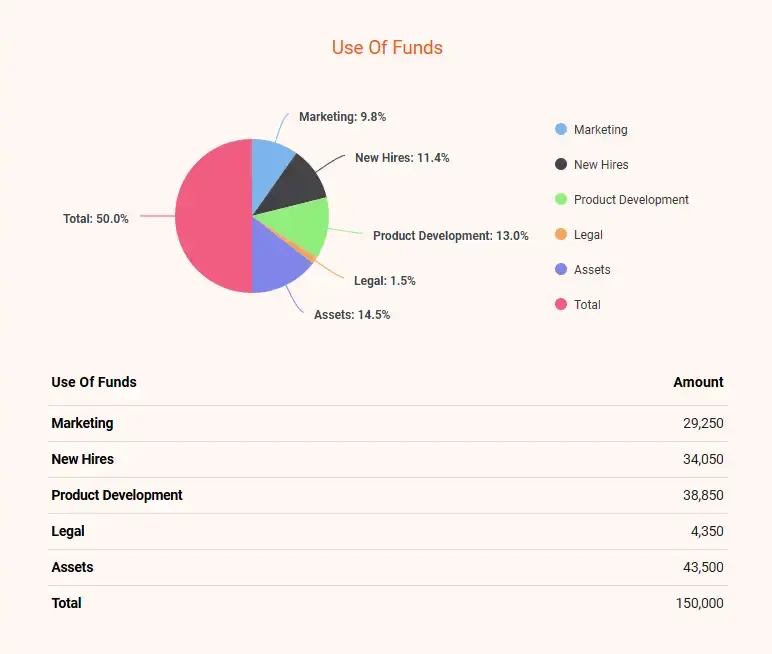Opening a thrift store can be a great way to bring unique, affordable finds to your community while making a profit.
But the secret to growing a successful store isn’t just about filling racks with second-hand goods; it’s about having a solid business plan that will help you manage everything from inventory to attracting loyal customers.
Wondering how to write a plan?
No worries! This thrift store business plan example will walk you through every step of drafting an actionable plan that makes a real difference! But first…
Why do you need a thrift store business plan?
A thrift store business plan is essential whether you're launching a new store or expanding an existing one. Here's how it helps:
- Secure funding: A business plan shows potential investors or lenders that you have a clear strategy in place and are more likely to generate a return on their investment.
- Stay focused: It keeps you on track with your goals, such as sourcing quality inventory, meeting sales targets, or expanding your offerings.
- Ensure compliance: A business plan helps address necessary legal and regulatory steps, reducing risks that could affect your operations.
- Understand the market: It offers valuable insights into your customers, competitors, and what makes your thrift store unique.
In short, keeping a thrift store business plan is your roadmap to success, helping you stay on track and overcome challenges as your store grows.
Thrift store business plan sample
If you're starting a new thrift store or aiming to expand an existing one, this TreasureNest Thrift business plan example will help you outline the essential elements of your own plan. Let’s dive in!
1. Executive summary
Business name: TreasureNest Thrift
Location: 410 Vintage Boulevard, Suite 105, Portland, Oregon, 97209, USA
Business structure: LLC
TreasureNest Thrift is a community-focused thrift store, offering a curated selection of second-hand clothing, furniture, home décor, and accessories. With a welcoming atmosphere and a treasure-hunting vibe, TreasureNest Thrift caters to individuals seeking unique finds and budget-friendly solutions.
TreasureNest Thrift is about affordability, sustainability, and support for the community—our goal is to bring quality goods at affordable prices while reducing landfill waste and contributing to our community.
Mission statement
TreasureNest Thrift provides affordable, sustainable shopping with high-quality second-hand products in a safe, community-focused space. We aim to reduce waste and support our local community through sustainable practices.
Target market
Our primary target market includes:
- The budget-conscious consumers and families that need low-priced clothes and house furnishings.
- Environmentally concerned buyers who would prefer sustainability and reduce waste.
- Students and young professionals looking for something unique and old.
- For local artists and decorators who need materials and furniture at affordable prices.
- People who back businesses that contribute back to society as well as are concerned about sustainability.
Marketing strategy
We’ll use a mix of online and offline tactics to connect with customers and grow our community.
- Social media campaigns to showcase new arrivals and sales.
- Community engagement through events, donation drives, and sustainability workshops.
- A loyalty rewards program and referral incentives.
- Collaborations with local charities and eco-focused organizations.
Financial highlights
TreasureNest Thrift is designed for steady growth, balancing affordability with sustainability. Here’s an outlook of our financial projections, outlining expected revenue, profit, and operating costs over the first three years.
| Category | Year 1 | Year 2 | Year 3 |
|---|---|---|---|
| Total Revenue | 360,000 | 417,000 | 480,000 |
| Cost of Goods Sold (COGS) | (55,000) | (68,000) | (82,000) |
| Gross Profit | 305,000 | 349,000 | 398,000 |
| Operating Expenses | (180,200) | (206,500) | (233,000) |
| Operating Profit | 124,800 | 142,500 | 165,000 |
| Other Expenses (Loan Interest + Taxes) | (32,000) | (35,000) | (38,000) |
| Net Profit | 92,800 | 107,500 | 127,000 |
| Net Profit Margin (%) | 25.8% | 25.8% | 26.4% |
Liking the plan you're reading? It's AI generated.
Generate Your Own Using Bizplanr AI
2. Business description
Business model
TreasureNest Thrift is dedicated to offering the finest second-hand products at economical prices, contributing to environmental sustainability and waste reduction. It isn't just an affordable shop; it’s a venue for eco-friendly, budget-conscious customers wishing to discover authentic and quality-used products.
Vision statement
Our vision is to make second-hand shopping the top choice by showcasing the value of pre-loved items. TreasureNest Thrift aims to lead eco-friendly retail while inspiring communities to embrace sustainability, affordability, and individuality.
Core values
- Sustainability: Reducing environmental impact through resale and recycling.
- Affordability: Ensuring high-quality items available to all customers.
- Community-focused: Supporting local communities and projects while building strong relationships via events and partnerships.
- Creativity: Empowering individuality with one-of-a-kind treasures.
Background history
TreasureNest Thrift was founded to make second-hand shopping affordable, sustainable, and exciting. Inspired by the idea of uncovering hidden gems in a welcoming space, the store offers quality gently used items while promoting eco-friendly living. The name "TreasureNest" reflects this mission—helping customers find unique treasures in a cozy, home-like environment.
Future goals
Our future goals include:
- Broaden inventory: Offer a wider variety of unique, high-quality second-hand items.
- Build local partnerships: Strengthen relationships through community-focused events and initiatives.
- Boost online reach: Expand our digital presence to serve a larger customer base.
- Support community causes: Increase funding for local outreach and charity programs.
3. Industry and market analysis
Industry overview
The thrift and resale industry in the United States is booming. This rapidly growing industry is stimulated by growing consumer consciousness in areas of sustainability, environment, and affordability.
Thrift shopping has been steadily rising over the last five years, with ever-growing profits and consumer demand. Thrift store industry revenues as of 2024 would stand at an impressive $14.8 billion and has the potential for further growth in the next couple of years.
Market trends
Emerging trends in a thrift store industry are:
- Sustainability focus: Consumers are focusing more on waste reduction and support eco-friendly products through second-hand shopping.
- E-commerce growth: Online platforms are contributing to an extension of the used market to include online markets as well as second-hand shops
- Millennial and Gen Z influence: This younger generation has chosen affordable and sustainable shopping instead of fast fashion.
- Circular economy: Growing interest in reusing and recycling goods fosters the growth of the resale
Regulatory requirements
Thrift stores must follow:
- Tax regulations: Resale businesses must follow tax laws for sales, income, and reporting.
- Consumer protection laws: Thrift stores must ensure the safety and quality of second-hand goods, including proper labeling.
- Environmental laws: Businesses may need to follow local regulations on waste management and recycling.
- Licensing and permits: Thrift stores may require specific licenses or permits, especially for online sales or certain goods like electronics.
4. Customer analysis
Target customer
TreasureNest Thrift focuses on a diverse group of people who care about sustainability, affordability, and unique shopping experiences. They are:
1) Budget-friendly shoppers
People looking for affordable options for clothes, furniture, and home goods. They’re smart about saving money and love finding great deals without sacrificing quality.
2) Eco-conscious buyers
Shoppers who care about the planet and prefer second-hand items over new ones to reduce waste and live sustainably.
3) Students and young professionals
Young people who want trendy or vintage items to express their style or decorate their spaces without spending a fortune.
4) Creative types
Local artists, crafters, and decorators who love unique finds and often repurpose thrifted items for projects or creative use.
5) Community supporters
Residents who value supporting local businesses that give back to the community and foster charitable causes.
Customer needs
TreasureNest Thrift is designed to address the specific needs and desires of its target customers:
- Affordability: Selling second-hand products at competitive prices, TreasureNest Thrift offers a cost-effective alternative to new retail.
- Sustainability: Clients could align their shopping behavior with their green-conscious values by buying reused and upcycled items.
- Unique offerings: A handpicked selection provides access to fashionable, high-quality, and exclusive pieces.
- Community impact: Customers feel good about supporting the business where they are making a difference locally, whether it's through donation drives or partnerships.
5. Competitive analysis
TreasureNest Thrift competes with several established thrift and resale businesses in Portland. Here's a closer look at our competition and how we differentiate ourselves:
Key competitors
1) Goodwill Portland
It’s a well-known thrift chain, offering a wide variety of items at affordable prices. However, its lack of curation and impersonal shopping experience leaves room for TreasureNest to stand out with a more boutique-style and personalized approach.
2) Buffalo Exchange
Caters to young adults with trendy and fashion-forward clothing but has a limited selection, focusing only on apparel. TreasureNest goes beyond clothing to offer furniture, home décor, and DIY materials, giving customers more variety.
3) Value Village
Operates large-scale stores with affordable pricing, but its warehouse-like shopping environment doesn’t offer a welcoming or community-focused experience. TreasureNest provides a warm, boutique-style atmosphere that emphasizes sustainability and local connections.
Competitive edge
We offer a more curated selection of higher-quality items, put a strong emphasis on sustainability, and genuinely connect to the Portland community, and that is what sets TreasureNest Thrift apart. We bring together affordability, variety, and eco-conscious values in a way that bigger chains and niche competitors cannot match.
SWOT analysis
6. Products and services
TreasureNest Thrift offers a carefully curated selection of second-hand goods that combine quality, affordability, and sustainability.
Product categories
The table below outlines the key product categories offered by TreasureNest Thrift, their features, and customer benefits.
| Product Category | Description | Features | Customer Benefits |
|---|---|---|---|
| Clothing | A wide range of second-hand apparel for men, women, and children. | Stylish and affordable, includes vintage and trendy pieces. | Affordable fashion, eco-friendly shopping, unique wardrobe options. |
| Furniture | Pre-loved furniture, including sofas, chairs, tables, and shelves. | High-quality, durable pieces with character; includes repurposed and upcycled items. | Affordable home furnishings, one-of-a-kind designs, sustainability-focused décor. |
| Home Décor | Items like vases, wall art, mirrors, and seasonal decorations. | Curated, stylish pieces that blend vintage and modern aesthetics. | Adds personality to homes at a fraction of retail prices. |
| Accessories | Jewelry, handbags, hats, and scarves. | Unique, gently used accessories; includes handmade items from local artisans. | Affordable ways to accessorize and express individual style. |
| Books and Media | Pre-owned books, magazines, DVDs, and vinyl records. | Wide variety of genres and formats at low prices. | Affordable entertainment, great finds for collectors and book lovers. |
| Specialty Items | Unique, limited-edition items like antique goods, collectibles, or rare finds. | Rotating selection of "treasure" pieces that appeal to vintage enthusiasts and collectors. | Excitement of discovering rare and valuable items while supporting sustainability. |
| DIY Materials | Fabric scraps, craft supplies, and small furniture perfect for upcycling. | Affordable supplies for creative projects and DIY endeavors. | Helps customers create customized items while reducing waste. |
Unique selling points
- Curated inventory: High-quality, stylish, and handpicked items that stand out from traditional thrift stores.
- Sustainability focus: Promoting eco-friendly practices through reuse, upcycling, and waste reduction.
- Affordable pricing: Luxury and value at prices that fit every budget.
- Community-centric approach: Deep local connections through events, partnerships, and donation drives.
Additional services
- Donation drop-offs: Convenient drop-off locations for customers to donate items.
- Loyalty program: Rewarding repeat customers with discounts and special offers.
- Workshops and events: Hosting community-focused activities and learning opportunities.
- Online store: Expanding the shopping experience through a digital platform.
7. Marketing Plan
TreasureNest Thrift’s marketing plan focuses on social media, a simple website, and email updates online while using flyers, local events, and partnerships to connect with the community
Online marketing
- Social media: Be active on Instagram and Facebook through posts to engage people and keep good track of new collections, sales, and sustainability tips from customers.
- Website: Create a user-friendly website with an online store, a sustainability blog, donation guidelines, and event updates to drive traffic and attract online shoppers.
- Email campaigns: Send out periodic newsletters that could include promotions, new inventory, and other community event news.
Offline advertising
- Flyers and posters: Distribute marketing materials at strategic locations like community centers, coffee shops, libraries, and schools to reach local shoppers.
- Community events: Host donation drives, upcycling workshops, and sustainability talks to connect with Portland residents and establish a local-focused mission for TreasureNest.
- Local collaborations: Partner with local eco-friendly businesses and nonprofits for cross-promotions to increase visibility and strengthen brand identity.
Sales strategy
- Exceptional in-store experience: Offer a friendly welcoming environment, having a well-managed team which would encourage browsing and revisit of customers.
- Seasonal promotions: Create sales and offers that happen on holidays, like Earth Day or back-to-school, so sales are optimized for peak season.
- Loyalty program: Reward repeated shoppers and donors with discounts or points usable on successive purchases, encouraging retention.
Distribution channels
- In-store sales: The primary channel, offering a curated shopping experience that aligns with TreasureNest’s boutique-style concept.
- Online store: A secondary channel, allowing customers to shop from a curated selection online and extending reach beyond the local Portland community.
Pricing strategy
- Affordable pricing: Ensure competitive pricing while maintaining high quality to appeal to budget-conscious shoppers.
- Special discounts: Provide exclusive discounts for donors, students, or loyal customers to create goodwill and encourage repeat visits.
8. Management team
TreasureNest Thrift is a small team of very experienced people each contributing their skill set to ensure success in this shop.
Key managers
Amelia Hayes – CEO (Owner)
Amelia heads TreasureNest Thrift; she has retail experience of more than 10 years and drives the store strategically, including policy, partnerships, and long-term goals.
Ethan Carter – COO (Manager)
He oversees every day's process to ensure proper running of the store. In retail management for 8 years, he directs the staff with inventory and takes care of great customer experience.
Rachel Monroe – CFO (Accountant)
Rachel keeps all financial work of the company, from preparing budgets and all financial planning in the company. Being a professionally qualified accountant Rachel keeps the profit margin for her store within range and within plans.
Olivia Reed – Marketing Manager
Olivia leads marketing in the store. She manages social media, email campaigns, and events by connecting with customers to promote TreasureNest's mission. With 6 years of marketing experience, she knows how to get the word out effectively.
Organization chart
9. Financial plan
The financial plan provides a roadmap for TreasureNest Thrift’s profitability over the next three years. The projections reflect steady revenue growth, cost management, and reinvestment into the business.
Income statement
| Category | Year 1 | Year 2 | Year 3 |
|---|---|---|---|
| Revenue | |||
| Retail Sales Revenue | 300,000 | 345,000 | 390,000 |
| Online Sales | 50,000 | 60,000 | 75,000 |
| Other Income | 10,000 | 12,000 | 15,000 |
| Total Revenue | 360,000 | 417,000 | 480,000 |
| Cost of Goods Sold (COGS) | |||
| Inventory Purchases | 40,000 | 50,000 | 60,000 |
| Processing Costs | 15,000 | 18,000 | 22,000 |
| Total COGS | 55,000 | 68,000 | 82,000 |
| Gross Profit | 305,000 | 349,000 | 398,000 |
| Operating Expenses | |||
| Rent & Utilities | 36,000 | 38,000 | 40,000 |
| Employee Salaries | 90,000 | 105,000 | 120,000 |
| Marketing & Advertising | 18,000 | 22,000 | 25,000 |
| Supplies & Equipment | 10,000 | 12,000 | 15,000 |
| Transportation Costs | 6,000 | 7,000 | 8,000 |
| Credit Card Fees | 4,500 | 5,500 | 6,500 |
| Insurance & Licenses | 7,200 | 8,000 | 9,000 |
| Depreciation | 8,500 | 9,000 | 9,500 |
| Total Operating Expenses | 180,200 | 206,500 | 233,000 |
| Operating Profit | 124,800 | 142,500 | 165,000 |
| Other Expenses | |||
| Loan Interest | 12,000 | 10,000 | 8,000 |
| Taxes | 20,000 | 25,000 | 30,000 |
| Total Other Expenses | 32,000 | 35,000 | 38,000 |
| Net Profit | 92,800 | 107,500 | 127,000 |
Cash flow statement
| Category | Year 1 | Year 2 | Year 3 |
|---|---|---|---|
| Cash Inflows | |||
| Cash Sales (In-store & Online) | 350,000 | 405,000 | 470,000 |
| Loan Proceeds | 20,000 | 0 | 0 |
| Other Income (Memberships, etc.) | 10,000 | 12,000 | 15,000 |
| Total Cash Inflows | 380,000 | 417,000 | 485,000 |
| Cash Outflows | |||
| Rent & Utilities | (36,000) | (38,000) | (40,000) |
| Employee Salaries | (90,000) | (105,000) | (120,000) |
| Inventory Purchases | (40,000) | (50,000) | (60,000) |
| Marketing & Advertising | (18,000) | (22,000) | (25,000) |
| Supplies & Equipment | (10,000) | (12,000) | (15,000) |
| Loan Repayment | (10,000) | (12,000) | (14,000) |
| Taxes | (20,000) | (25,000) | (30,000) |
| Total Cash Outflows | (224,000) | (264,000) | (304,000) |
| Net Cash Flow | 156,000 | 153,000 | 181,000 |
| Beginning Cash Balance | 10,000 | 166,000 | 319,000 |
| Ending Cash Balance | 166,000 | 319,000 | 500,000 |
Balance sheet
| Category | Year 1 | Year 2 | Year 3 |
|---|---|---|---|
| Assets | |||
| Cash Balance | 166,000 | 319,000 | 500,000 |
| Accounts Receivable | 5,000 | 6,000 | 7,000 |
| Inventory | 40,000 | 50,000 | 60,000 |
| Equipment (net of depreciation) | 35,000 | 36,000 | 38,000 |
| Total Assets | 246,000 | 411,000 | 605,000 |
| Liabilities | |||
| Accounts Payable | 5,000 | 6,000 | 7,000 |
| Loan Payable | 10,000 | 8,000 | 6,000 |
| Taxes Payable | 5,000 | 7,000 | 9,000 |
| Total Liabilities | 20,000 | 21,000 | 22,000 |
| Owner's Equity | |||
| Owner's Capital | 30,000 | 35,000 | 40,000 |
| Retained Earnings | 196,000 | 355,000 | 543,000 |
| Total Owner's Equity | 226,000 | 390,000 | 583,000 |
| Total Liabilities & Equity | 246,000 | 411,000 | 605,000 |
Funding needs
We need $150,000 to launch—covering store renovations, inventory, marketing, staff, new hires, products, and online store to expand our reach.
Download free thrift store business plan template
Ready to start drafting your thrift store business plan from scratch? But need some help getting it right? No worries! Download our free thrift store business plan template in PDF and get started today.
This lender-ready template is specifically designed for thrift store owners. With real-life examples and helpful tips, it’ll guide you in creating a solid business plan. You can even modify it to match your unique business needs.
Conclusion
With this thrift store business plan template, you now have a clear path to creating a professional and detailed business plan for your thrift store.
But, if you need a quick, easy way to build a comprehensive plan, consider using Bizplanr. It’s an AI business plan generator that simplifies the process, helping you create a detailed plan in minutes.
Just answer a few simple questions about your business idea, and get an investor-friendly plan ready to go.
Get Your Business Plan Ready In Minutes
Answer a few questions, and AI will generate a detailed business plan.
Frequently Asked Questions
How can I get funding for my thrift store business plan?
To secure funding for your thrift store, you can explore several options:
- Bank loans: Apply for a small business loan by presenting your business plan to a bank or financial institution.
- Grants: Explore grants for small businesses, non-profits, or eco-friendly initiatives.
- Investors: Find investors who share your vision and are open to funding in exchange for equity or other arrangements.
- Crowdfunding: Use platforms like GoFundMe or Kickstarter to raise money from supporters who believe in your mission.
- Personal savings: Consider self-funding if other funding options are unavailable.
What financial projections should be included in a non-profit thrift store business plan?
You should include the following key financial projections in your non-profit thrift store business plan:
- Income statement (profit and loss statement)
- Cash flow statement
- Balance sheet
- Break-even analysis
- Sales and revenue forecast
- Expense budget
- Funding needs
Can I use templates or tools to write my thrift store business plan?
Yes, you can use free templates from websites like Bplans, Upmetrics, LivePlan, and SCORE to get a structured framework for your thrift store business plan. These tools guide you step by step, making it easier to cover all the important details and create a professional business plan.
How long should a thrift store business plan be?
Your thrift store business plan should be 15 to 30 pages long, depending on the complexity of your business operations, the type of business plan you’re writing, as well as the level of detail.










